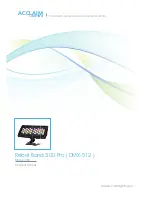
5
Troubleshooting
Here are some troubleshooting suggestions:
A. The fixture does not work, there is no light output.
1.) Check the connection of power and main fuse.
2.) Measure the voltage output on your power receptacle to ensure proper voltage.
B. Fixture does not respond to DMX control.
1.) DMX LED should be on. If not, check DMX connectors and cables for proper
connection.
2.) If DMX LED is on but not responding to a channel, check the DMX address
settings and DMX polarity.
3.) If you have intermittent DMX signal problems, check the pins on the cable
connectors and on the fixture.
4.) Try to use a different DMX controller.
5.) Interference may occur if DMX cables are run alongside high voltage cables.
C. Fixture responds erratically to DMX control.
1.) You may have a break in the DMX cabling. Check the LED for the response of
the master/ slave mode signal.
2.) Wrong DMX address in the fixture. Set the fixture to the proper address.
3.) Use of microphone cables for DMX connections can cause errors
D. The fixture doesn’t respond to sound.
1.) Make sure the fixture is not set to receive a DMX signal.
2.) Check the fixture’s internal microphone by tapping the microphone.
DMX General Information
The DMX512 digital communication protocol was introduced to control stage lighting
and special effects.
The DMX standard features 512 available channels, and they are assignable in any
sequence that conforms to the user’s needs. Each DMX-capable fixture requires
one or more sequential channels. A starting address, which indicates the first control
channel reserved for that particular fixture, must be assigned to the fixture before
the controller can recognize it. DMX controllable fixtures may vary in the number of
channels they require, depending on the fixtures features and/or functionality.
Channels should never be permitted to overlap; otherwise, for example, a fader that
controls blue output on one fixture may cause strobing or dimming on an adjacent,
incorrectly assigned fixture. Multiple fixtures of the same type that use an identical
starting address will function in unison. Fixtures assigned properly spaced starting
addresses will operate individually, but a DMX controller with sufficient channels can
be configured to run these same fixtures either combined or independently.
The sequence in which DMX fixtures are connected has no effect on how a controller
communicates with each individual lighting fixture. Although 3-pin XLR mic cables
may be used to connect DMX fixtures over short runs, longer distances will introduce
data errors due to the mic cable’s incorrect impedance. For best results, Talent
Sound & Lighting recommends the use of correct 120 ohm, low-capacitance, twisted
pair cable designed for the DMX512 protocol. It is also suggested that a termination
resistor plug be used on the output connector of the last fixture in an array of DMX
instruments. This resistance ensures proper data transmission.
























